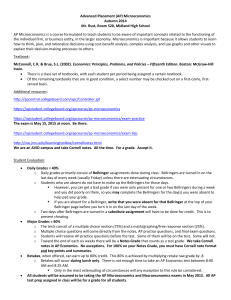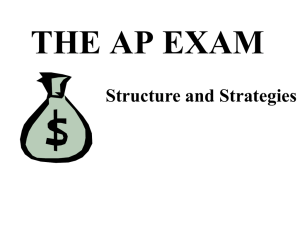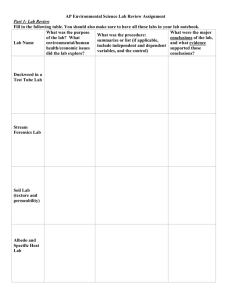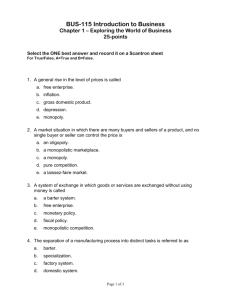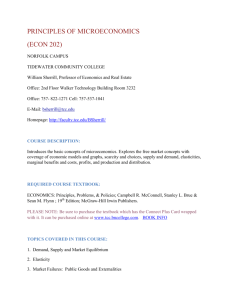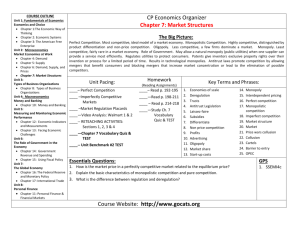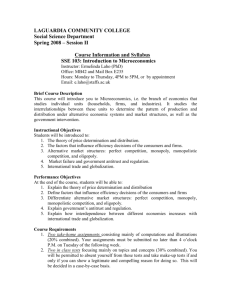AP Microeconomics Syllabus - Midland High School
advertisement
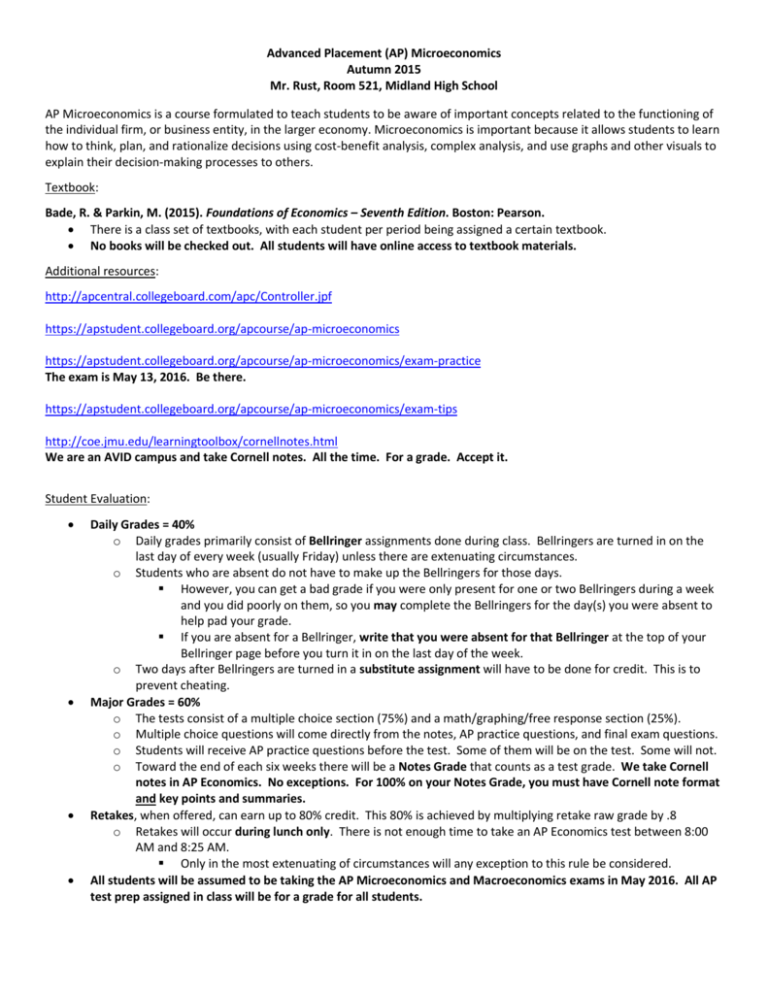
Advanced Placement (AP) Microeconomics Autumn 2015 Mr. Rust, Room 521, Midland High School AP Microeconomics is a course formulated to teach students to be aware of important concepts related to the functioning of the individual firm, or business entity, in the larger economy. Microeconomics is important because it allows students to learn how to think, plan, and rationalize decisions using cost-benefit analysis, complex analysis, and use graphs and other visuals to explain their decision-making processes to others. Textbook: Bade, R. & Parkin, M. (2015). Foundations of Economics – Seventh Edition. Boston: Pearson. There is a class set of textbooks, with each student per period being assigned a certain textbook. No books will be checked out. All students will have online access to textbook materials. Additional resources: http://apcentral.collegeboard.com/apc/Controller.jpf https://apstudent.collegeboard.org/apcourse/ap-microeconomics https://apstudent.collegeboard.org/apcourse/ap-microeconomics/exam-practice The exam is May 13, 2016. Be there. https://apstudent.collegeboard.org/apcourse/ap-microeconomics/exam-tips http://coe.jmu.edu/learningtoolbox/cornellnotes.html We are an AVID campus and take Cornell notes. All the time. For a grade. Accept it. Student Evaluation: Daily Grades = 40% o Daily grades primarily consist of Bellringer assignments done during class. Bellringers are turned in on the last day of every week (usually Friday) unless there are extenuating circumstances. o Students who are absent do not have to make up the Bellringers for those days. However, you can get a bad grade if you were only present for one or two Bellringers during a week and you did poorly on them, so you may complete the Bellringers for the day(s) you were absent to help pad your grade. If you are absent for a Bellringer, write that you were absent for that Bellringer at the top of your Bellringer page before you turn it in on the last day of the week. o Two days after Bellringers are turned in a substitute assignment will have to be done for credit. This is to prevent cheating. Major Grades = 60% o The tests consist of a multiple choice section (75%) and a math/graphing/free response section (25%). o Multiple choice questions will come directly from the notes, AP practice questions, and final exam questions. o Students will receive AP practice questions before the test. Some of them will be on the test. Some will not. o Toward the end of each six weeks there will be a Notes Grade that counts as a test grade. We take Cornell notes in AP Economics. No exceptions. For 100% on your Notes Grade, you must have Cornell note format and key points and summaries. Retakes, when offered, can earn up to 80% credit. This 80% is achieved by multiplying retake raw grade by .8 o Retakes will occur during lunch only. There is not enough time to take an AP Economics test between 8:00 AM and 8:25 AM. Only in the most extenuating of circumstances will any exception to this rule be considered. All students will be assumed to be taking the AP Microeconomics and Macroeconomics exams in May 2016. All AP test prep assigned in class will be for a grade for all students. Rules and Expectations: 1.) All students should respect classmates, teachers, and guests to the classroom at all times. 2.) Students should not cheat, ever. Honesty counts. 3.) All school rules regarding cell phones, dress code, food and drink, and personal behavior are always in effect. 4.) Do your own work when you’re supposed to do it. Late work will lose credit fast. 5.) Treat others as you would like to be treated. Tutorial Times: Tutorials and make-up opportunities for missed assignments are held in Room 521 before school, from 8:00 to 8:25 AM, and over lunch. For other times, please contact Mr. Rust to schedule a meeting. Unit 1: Basic Economic Concepts (4 ½ weeks) Chapter 1: Getting Started (p. 1-30) Chapter 2: The U.S. and Global Economies (p. 31-56) Chapter 3: The Economic Problem (p. 57-80) Chapter 13: Consumer Choice and Demand (p. 315-342) Chapter 6: Efficiency and Fairness of Markets (p. 137-166) Unit 1.5: Supply and Demand Chapter 4: Demand and Supply (p. 81-110) Chapter 7: Government Actions in Markets (p. 167-188) Chapter 5: Elasticities of Demand and Supply (p. 111-136) Date Concepts/Information Learned August 26 Course Overview/Classroom Rules August 27 Introduction, Why We Graph, Ceteris Paribus August 28 Economic Way of Thinking September 1-3 Scarcity, Production Possibilities Curve, Implicit and Explicit Costs September 4, 8 Economic Systems September 9 Review, Quiz? September 10-11 Comparative and Absolute Advantage September 14-18 Supply & Demand Marginal analysis Income effect Substitution effect Diminishing marginal utility Consumer surplus September 21-25 Price Elasticity of Demand Total Revenue test Calculating Elasticity Coefficients Income Elasticity of Demand Cross Elasticity of Demand September 28 Working on Graphs Review for Test September 29 Unit 1 Exam Unit 2: Nature and Function of Product Markets; Perfect Competition (2 ½ weeks) Chapter 14: Production and Cost (p. 343-370) Chapter 15: Perfect Competition (p. 371-398) Date Concepts/Information Learned September 30 Market Structure Overview Product Differentiation October 1-7 Costs Diminishing Marginal Returns Normal profits Economic profits Long Run/Short Run Costs of Production (ATC, AVC, MC, AFC) October 8-14 Revenue, cost, profit Perfect Competition Profit, Loss, Break-Even, Shut Down Long Run Equilibrium Productive Efficiency Allocative Efficiency LRAC and SRAC Economies and Diseconomies of Scale October 15 Review for Unit 2 exam October 16 Unit 2 Exam Unit 3: Perfect Competition, Monopoly, Monopolistic Competition, Oligopoly (2 ½ weeks) Chapter 16: Monopoly (p. 399-430) Chapter 17: Monopolistic Competition (p. 431-454) Chapter 18: Oligopoly (p. 455-482) Date Concepts/Information Learned October 19-20 Monopoly Downward sloping demand curve Consumer and producer surplus October 21-23 Regulating Monopoly Socially Optimal Price Fair-Return Price Price Discrimination October 26 Quiz on Monopolies October 27-30 Monopolistic Competition Long Run Equilibrium in Monopolistic Competition November 1-4 Oligopoly Cartel Game Theory Herfindahl Index Kinked Demand Curve November 5 Review November 6 Unit 3 Exam Unit 4: Factor Markets (2 weeks) Chapter 19: Markets for Factors of Production (p. 483-507) Date Concepts/Information Learned November 9 Circular Flow of Economic Activity review November 10-12 Derived Demand MRC = MRP Least Cost/Profit Maximizing Combination of Resources MRP in perfectly competitive markets vs. imperfectly competitive markets November 13-17 Wage Discovery in Competitive Markets Role of Unions Monopsony Minimum Wage Argument Distribution of Income November 18 Economic Rent November 19 Review November 20 Unit 4 Exam HAPPY THANKSGIVING!!! Unit 5: Market Failure and the Role of Government (3 weeks) Chapter 7: Government Actions in Markets (p. 167-188) Chapter 8: Taxes (p. 189-212) Chapter 10: Externalities (p. 241-264) Chapter 11: Public Goods and Common Resources (p. 265-290) Chapter 12: Markets with Private Information (p. 291-314) Date Concepts/Information Learned November 30 Role of Government Public Goods December 1-2 Externalities Market for Externality Rights Coase Theorem Marginal Analysis December 3-4 Market Failure Public Goods December 7 Taxes Tax Incidence December 8 Review December 9 Unit 5 Exam Post Unit 5: Semester Review, Make-Up Time, Link to Macroeconomics (Spring Semester) December 9-14 Review for Final Exam December 15-18 Final Exam Week
